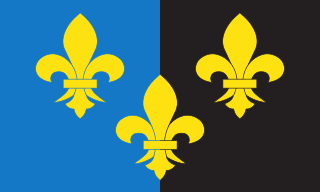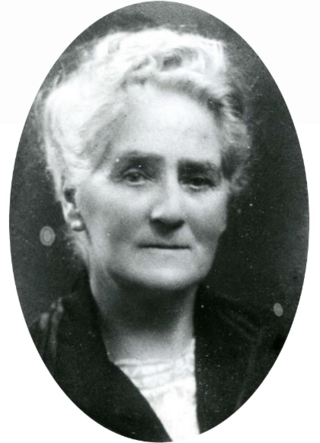
Aberdare is a town in the Cynon Valley area of Rhondda Cynon Taf, Wales, at the confluence of the Rivers Dare (Dâr) and Cynon. Aberdare has a population of 39,550. Aberdare is 4 miles (6 km) south-west of Merthyr Tydfil, 20 miles (32 km) north-west of Cardiff and 22 miles (35 km) east-north-east of Swansea. During the 19th century it became a thriving industrial settlement, which was also notable for the vitality of its cultural life and as an important publishing centre.

Henry Austin Bruce, 1st Baron Aberdare, was a British Liberal Party politician, who served in government most notably as Home Secretary (1868–1873) and as Lord President of the Council.

Until 1974, Monmouthshire, also formerly known as the County of Monmouth, was an administrative county in the south-east of Wales, on the border with England, and later classed as one of the thirteen historic counties of Wales. Its area now corresponds approximately to the present principal areas of Monmouthshire, Blaenau Gwent, Newport and Torfaen, and those parts of Caerphilly and Cardiff east of the Rhymney River.
The administration of education policy in the Britain began in the 19th century. Official mandation of education began with the Elementary Education Act 1870 for England and Wales, and the Education (Scotland) Act 1872 for Scotland. Education policy has always been run separately for the component nations of Britain, and is now a devolved matter.

Dwr-y-Felin Comprehensive School is a comprehensive school in the Cwrt Herbert community of the town of Neath in South Wales, Wales. The school badge shows a watermill and mill stream in reference to the school name, in English 'water of the mill' or 'mill stream'. The badge also uses the acronym DCS to represent Dwr-y-Felin Comprehensive School.

Glan Afan Comprehensive School was a mixed comprehensive school which served the town of Port Talbot, Wales, and its surrounding areas for 120 years. It was opened in 1896 as Port Talbot Intermediate School under the provisions of the Welsh Intermediate Education Act 1889. The school closed in July 2016 to facilitate the merger of Glan Afan itself, Cwrt Sart Comprehensive, Sandfields Comprehensive and Traethmelyn Primary School into the ultra-modern £40millon 'super-school', Ysgol Bae Baglan.

Ysgol Syr Hugh Owen is a bilingual comprehensive secondary school for pupils aged 11–18. The school is situated in Caernarfon, Gwynedd, Wales. The school was established in 1894, the first to be built under the Welsh Intermediate Education Act 1889, which was heavily influenced by the educator Sir Hugh Owen, after whom the school was named.

Mountain Ash Comprehensive School, known as MACS, is a comprehensive school near the town of Mountain Ash, Rhondda Cynon Taf, Wales. It is a mixed-sex school with approximately 950 pupils, including about 90 in the sixth form. The school was formerly known as Mountain Ash Grammar School and is located near the former Dyffryn Colliery.

Owen Owen was a Welsh schoolteacher who, after being headmaster of a successful private school for boys in Oswestry, Shropshire, became the first Chief Inspector of the Central Welsh Board for Intermediate Education.
The history of education in England is documented from Saxon settlement of England, and the setting up of the first cathedral schools in 597 and 604.

A direct grant grammar school was a type of selective secondary school in the United Kingdom that existed between 1945 and 1976. One quarter of the places in these schools were directly funded by central government, while the remainder attracted fees, some paid by a Local Education Authority and some by the pupils' parents or guardians. On average, the schools received just over half of their income from the state.

Aberdare High School was a comprehensive school in Aberdare, Wales.
Monmouth Comprehensive School is a comprehensive secondary school for pupils aged 11–18, situated in Monmouth, Monmouthshire, Wales.
A community school in England and Wales is a type of state-funded school in which the local education authority employs the school's staff, is responsible for the school's admissions and owns the school's estate. The formal use of this name to describe a school derives from the School Standards and Framework Act 1998.

Elementary schools were the first schools in England and Wales intended to give a basic education to the children of working class families. At the start of the 19th century, the only schooling available to these young people was run by private concerns or by charities, and was often of a very poor standard. In the first decades of that century, a network of elementary schools was established by societies backed by the Christian churches. In an effort to expand this "voluntary" system, the government made grants available to these societies, initially for new school buildings but later towards their running costs. It became apparent that although this system worked reasonably well in rural communities, it was far less successful in the rapidly expanding industrial cities, and that Britain was falling behind the rest of the developed world. In 1870, an act of parliament established elected school boards throughout England and Wales, which were empowered to create secular "board schools" funded by local taxation where there was no provision by the church societies. Further legislation made school attendance compulsory, and eventually free of charge. The problem of how the education of older pupils should be managed was solved by abolishing school boards in 1902 and passing responsibility to local councils. Elementary schools were eventually replaced in 1944 by the system of primary and secondary education.

The history of state education in Queensland commences with the Moreton Bay penal settlement of New South Wales in Australia, which became the responsibility of the Queensland Government after the Separation of Queensland from New South Wales in 1859.

Caleb Rees (1883–1970) was a Welsh school inspector for over forty years and a writer on educational and ecclesiastical topics.
Until the latter part of the 20th century, the teaching of Welsh history was predominantly taught from a British or Southern English perspective. But in recent decades, there has been a notable increase in emphasis on the teaching of Welsh history, a trend that has persisted into the 21st century.

Dilys Glynne Jones (1857–1932) was an advocate for the education of girls and women in Wales. The University College of North Wales lowered its flag to half mast on the day of her funeral.

The history of education in Wales spans from the period of Roman rule to the present day. Early forms of formal education were church or privately run and available to only a small segment of the population. In the 17th and 18th centuries significant efforts were made, mainly by charitable causes, to expand access to basic education. In the 19th century a state education system developed. By the end of the century, education had become free and compulsory for children aged 5 to 12 years. Further increases in the school leaving age and the development of a system of secondary schools led by the mid-20th century to universal secondary education—separate secondary schools for students of different academic abilities ended by 1980.
















